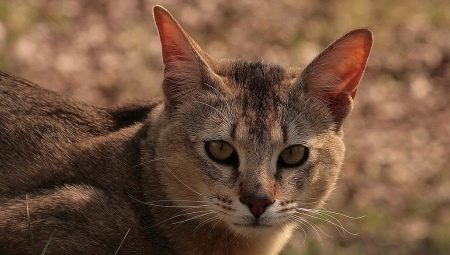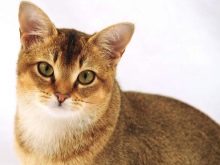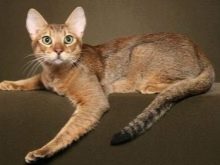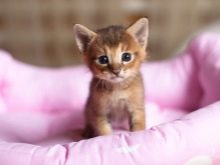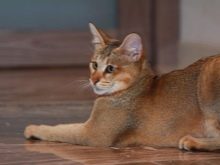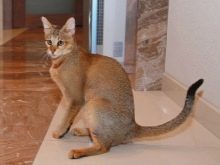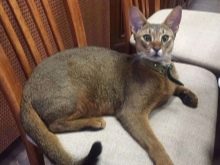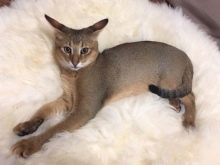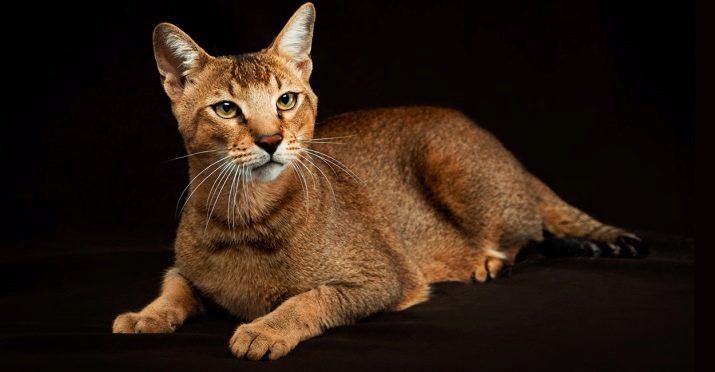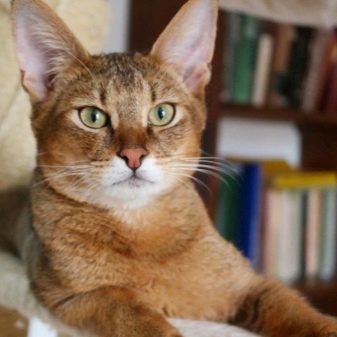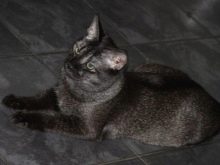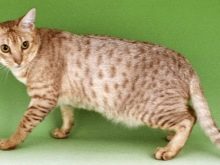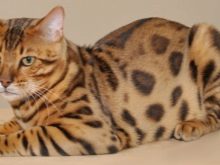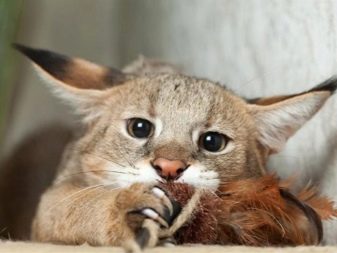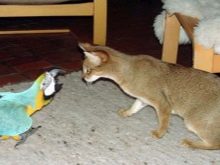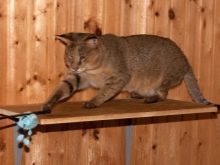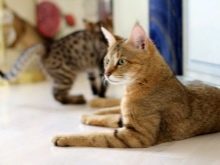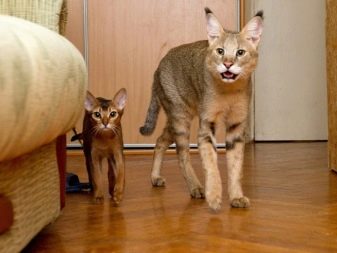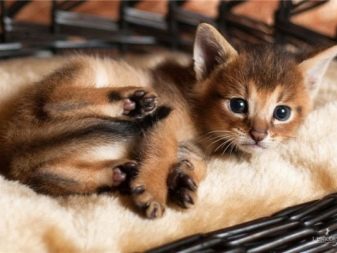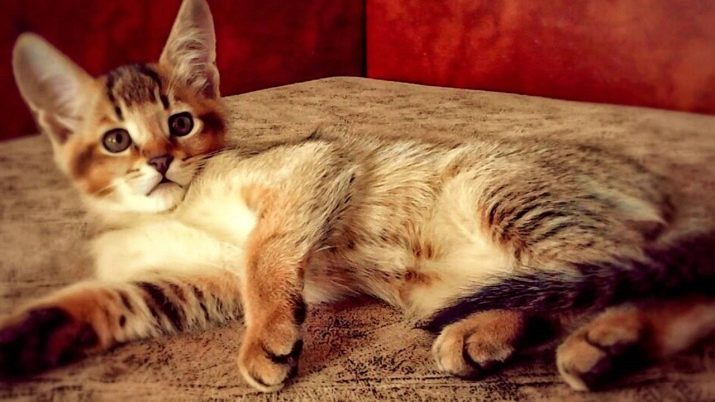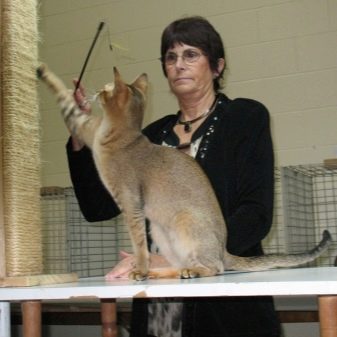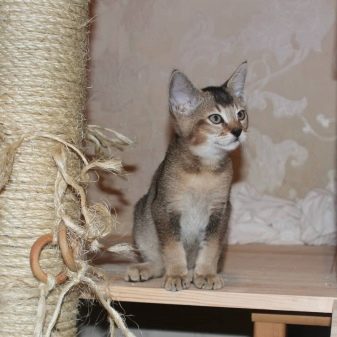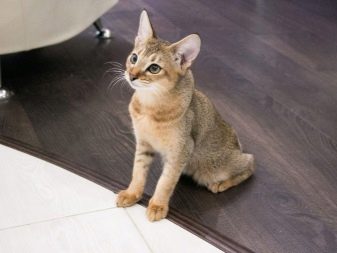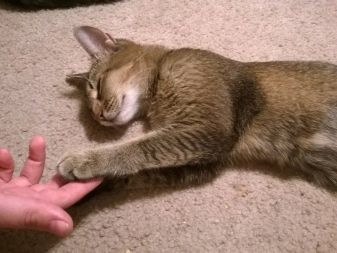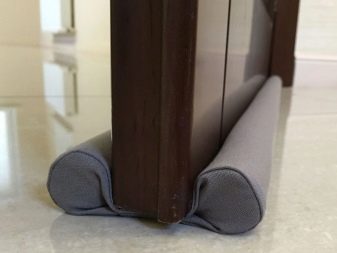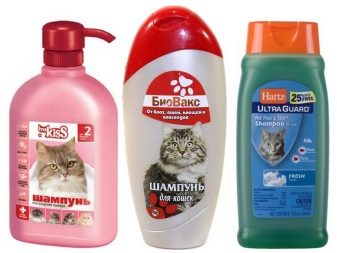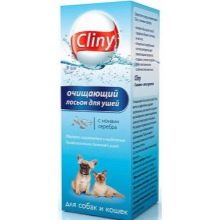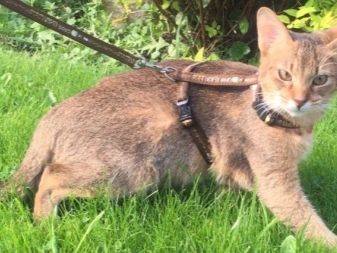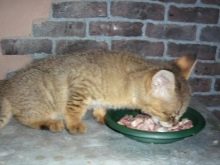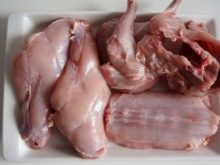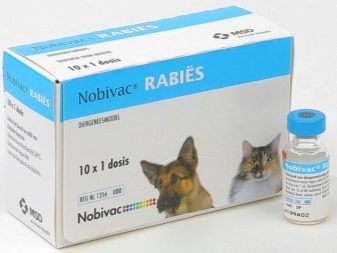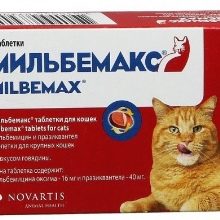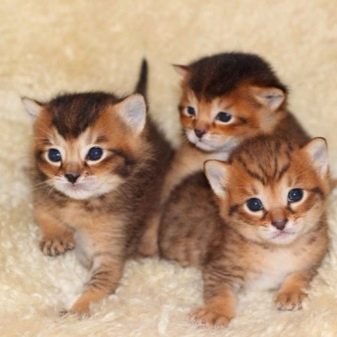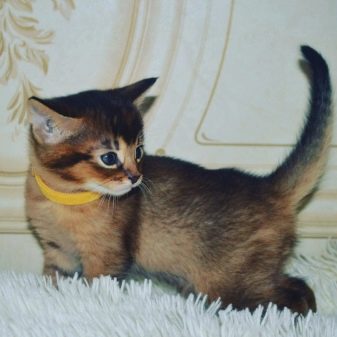Cats today are among the most popular pets and have gained wide distribution throughout the world. At the same time, globalization leads to the fact that people and their hobbies become more and more similar, and it becomes more and more difficult to stand out from the gray mass, because unusual breeds of pets that can surprise are in great demand. These include chauzis, which are ranked among the most expensive cats in the world - it would be quite possible to buy a car instead of such an animal.
History and distribution
Most of the famous and famous breeds have a rather long history, spanning at least several decades. This can not be said about the Chausi - This breed is not very well-known and certainly not old, with which, perhaps, the crazy high cost of its representatives is connected - there are just few such cats.
People have long liked wild cats of small size - many consider them more refined and attractive than ordinary domestic four-legged cats. It’s not very convenient to get a really wild animal at home - sometimes it is protected by law, sometimes it just behaves inappropriately for a resident of an apartment. Another thing is a mixture that can occur if a domestic cat in certain regions is allowed to get acquainted with wild relatives.
The reed cat is still found in many regions of Asia - for example, it can be found on the Caspian coast of Russia, and it is this animal that gave a wild piece of blood to modern pets.
Interestingly, the breed was not brought here at all, but in America, where local breeders at some point became interested in curious-looking kittens and decided to intervene in the natural course of events with their own corrections.
The goal was peculiar: the end result should look like a savage and have the same temperament, but at the same time be sweet and homely. It turned out not bad, because in 2003 the breed was officially recognized, having received the name in honor of the reed cat, which is scientifically called Felis chaus.
At the moment, in America, chauzi can no longer be called a big rarity, but they literally reached the post-Soviet space in the form of single copies. This not only allows you to stand out for its own originality, but also allows you to make good money on the breeding of such animals.
Description
Seeing the mention of a cat as a semi-wild creature, not every cat owner is willing to get acquainted with this breed. However, the children of the reed cat are not as terrible as one could imagine.
Appearance
The main characteristic of the breed is that visually they should substantially resemble their wild ancestors. In particular, the standards of the breed prescribes that the head of the animal, planted on a short, but very powerful neck, should be small, with angular cheekbones and a powerful chin, it is decorated with an elongated straight nose. On top of the skull is decorated with erect ears with tassels. The eyes of the predator resemble those of the puma - the incision is also slightly slanting, the eyes themselves are of amber color, although yellow, green and any mixed tones are also allowed.
The body of the predator has an elongated graceful shape with a deep chest.The massive torso rests on long and strong legs with widely spread fingers - this provides the animal with good stability. Crowned cat tail, whose length is almost equal to the length of the body.
Please note that such a beast is larger than the absolute majority of domestic cats - an adult animal can easily weigh up to 15 kilograms.
In this case, the size of the female is noticeably smaller than that of the male, but at the same time it is more active and mobile.
The wild origin has an effect on the animal's woolen coat — it is very thick, but short, that is, it saves from cold, but during movement it simply cannot catch hold of obstacles. The fur of the causi shines, combing or any other shaping gives in badly.
A true representative of the breed is only three colors - black a la grizzly, and ticked silver or tabby. Such a cat simply cannot be completely monophonic, if so, it means that they offer you a fake. In this case, the ear tassels and the tip of the tail will be black anyway, and the pattern is clearly visible only on the tail, paws and muzzle, while in other places it merges.
In fairness it should be noted that The appearance of the chausi is greatly influenced by how much wild blood there is in it, but we will take a closer look at this aspect in detail.
Character
The behavior of the chausi is an absolutely incredible mix of domestic and wild habits, therefore inexperienced cat-lovers will surely be shocked by some of the tricks of their unusual pet. However, it is only more interesting. Do not worry, in general, it is still the same affectionate domestic cat, which is attached to its owner and wants attention from him. Wildness is manifested in another, and potential owners should be warned about this.
Unlike most domestic felines, the chauzi are not at all afraid of water, swims well and are curious about the prospect of hunting for various prey, which is found on the surface of the water or in its thickness.
Also, representatives of this breed are interested in any elevation, from where it is convenient to observe the surrounding terrain, so do not be surprised if the pet will regularly climb onto a cupboard or a mezzanine, choosing a place under the ceiling.
Another “barbaric” habit of an animal is that it is stored on food for a “rainy day”. The fact that you feed your pet every day at the same time and diligently stick to the chosen schedule doesn’t affect the situation at all - it is an instinct, the cat just wants to be confident in tomorrow's house. He will try to hide his supplies so that no one finds them, but in the apartment you will, of course, sooner or later find them.
A curious feature of the breed is amazing sociability of these animals. This is absolutely not the kind of pet that normally perceives loneliness - a chauzi really needs someone’s company, and if the owner is lost, the beast will try to make friends with at least someone, even if it is a dog.
In addition, the predator's inquiring mind needs periodic logical tasks, therefore the pet will not mind at all if you sometimes teach it various tricks - especially if you reward him for his diligence and understanding.
Keep in mind that in the wild nature of reed cats lead a very active lifestyle, because such a pet - not a homebody and not quiet.
Getting such a baby, immediately think about where there will be a spacious enough place for his games - It is not worth the risk of turning the whole house into a training ground for cat training. In general, experienced cat owners are inclined to think that for such a semi-wild creature it will be much more comfortable to live in a private house with a large backyard territory, but it will be a bit crowded in an apartment.
Varieties
Chawzi is a holistic breed, no smaller breeds are distinguished from its representatives.At the same time, the population of these animals is heterogeneous, since in fact they are hybrids of a wild reed cat and a domestic cat. In the absolute majority of cases, of course, there is more “domestic” blood in the animal, but in general, the classification of the varieties is done precisely for this reason. Naturally, the differences between the different chowsi options are obvious - some of them are almost ordinary pets with a slight touch of wildness, others are a wild predator with minimal touch of manners.
In general, there are five classes of representatives of this breed:
- F1 - at least half of the animal's blood is “wild”, such pets are obtained if one of the parents was a purebred reed cat, or when mating two pets of the same class;
- F2 - such a cat had only a purebred “savage” grandfather, such pets appear when mixing an animal class F1 with a cat of any other breed;
- F3 - the blood of the reed cat is no more than 1/8, such pets are already in many respects ordinary domestic cats, only affected by unusual wild impurities;
- F4 - 1/16 of the blood of a wild ancestor;
- F5 - 1/32 of savage origin, it is almost impossible to determine by such an animal that it is pedigree and has characteristic roots.
Breeding
In many ways, chauzis are so expensive also because they are very difficult to breed. The fact is that in most cases, male kittens in the upper classes (first of all, F1 and F2) are sterile from birth.
In practice, this means that the F1 cat couple will not have calves: the male will not give offspring at all, and the female needs to be crossed either with a real wild cane cat or with a different breed, but then the young will be only F2.
For this reason independent breeding, and even in our conditions, where chausi practically do not occur, can be considered a matter of the greatest complexity. The maximum that can be done is to cross a high-class cat with ordinary domestic cats, producing kittens of class F2 and below. In general, the mating procedure is completely analogous to that of any other breeds, but it should be borne in mind that a semi-wild beast may offend a too timid and domestic cat.
If you have a cat Chauzi high enough class and you still decided to cross it with other breeds, note that To preserve the color and most of the other breed characteristics, it is necessary to carefully choose a partner for mating. The best challenger is the representative of the Abyssinian breed, since it was usually him who was taken by breeders to cross with reed cats. Bengalese cats and representatives of some short-haired breeds may act as a possible, but still not the best alternative.
The big problem is also the fact that the "wild" genes in cats of the lower classes are no longer dominant, because most of the kittens look completely normal, so they have to be carefully selected.
Content
As is clear from the foregoing, to have such a pet is not all, it is necessary to provide him with the right conditions for keeping, as a semi-wild four-legged may need a completely different approach than the one that a typical domestic cat needs. If by any means you decide to acquire chauzi, you should first ask how to properly contain this miracle.
Upbringing and training
In the wild, not only strength, speed and agility are important for the predator, but also a developed mind that helps build a strategy for catching prey. This chauzi is distinguished by its excellent acumen, because representatives of this breed are often praised for the simplicity of training - the pet understands the host at a glance, easily captures the relationship between the execution of commands and receiving a reward, and then just makes a living. For this reason, it is necessary from the very first day of your stay in the house to clearly explain to the kitten where is the cat's toilet, and where is the scraper.
Even in childhood, children are susceptible to learning, because it is better to immediately teach them the rules of life for adults than to retrain them later.
If you have long doubted who it is better to have - a cat or a dog, then chausi is probably the best solution for you, because the mind of this breed is quite enough to learn the typical commands for dogs. A well-trained animal can not only sit down and lie down at the request of the owner, it also meows, gives a paw and even “dies” picturefully at the command of the owner. It is rumored that such pets even know how to find and bring slippers to the owner - since representatives of the breed are not too modest in size, this is not a problem for them.
If you have some experience in dog training and are willing to devote a lot of time to this, you can try to learn the animal and more difficult tricks like dancing to music or jumping through a hoop.
Unlike many other animals, in the process of training chauzi are not lazy at all - on the contrary, they like the host’s society and communication with it, they try their best to please him, and the sharp mind only helps them in this. The mustached predator is very persistent, and it is possible that he wants to learn a new trick even more than you would like to see him.
Care
Wild origin for the owners of such cats is very useful - in nature, animals somehow do without human help, which was transmitted to the domesticated version. In general, of course, you can and should take care of the pet's health and appearance so that it looks good and feels the same way, but it certainly is not more difficult than with any other domestic cat.
For example, a tight coat of a pet needs to be combed weekly - thanks to this, the beast will look more attractive.
At the same time, it is advisable to choose not combs, the effect of which is completely unimpressive, but massage brushes with soft bristles - they stimulate blood circulation, and thus contribute to the growth of a new shiny coat.
Naturally, when an animal sheds, and it usually happens in the summer, it is necessary to carry out combing more often, because otherwise the predator can itch unceremoniously about everything that it sees.
As stated above, Chausi is not afraid of water and sometimes he would like to swim, which greatly simplifies hygiene. People who have experience of keeping such animals at home, say that you can bathe an animal quite often - usually it is only happy to have the opportunity to swim.
The only thing worth worrying about is that during the drying period after the bath the pet doesn’t get into a draft. In general, of course, this should not be a problem, because in the wild nature of reed cats no one hides from drafts, but this is your favorite - you should not risk his personal health just because it would not be a problem for someone.
If you are trying not only to give the animal a swim, but also to fully wash it, use specially manufactured soft consistency shampoos. You should not replace them with “human” means - practice shows that from ordinary shampoos the cat's coat loses its brightness and weakens.
In all other respects, predator care is simple: it is necessary to check the presence of sulfur in his ears at least once a week and remove it. As necessary, a similar procedure is done with the eyes - if mucus accumulates there, it should be removed as an environment for the potential reproduction of pathogens.
Ideally, an animal should be taught from childhood to daily teeth cleaning, or at least to regular oral examinations for various dental injuries and ailments. Finally, no scratching post will not cope with the rapidly growing pet's claws, because from time to time they need to be cut off with a special shears - usually such a need matures about twice a month.
Speaking of the fact that chawzi is a semi-wild animal, one must remember that for classes F1 and F2 this is not an exaggeration at all. Such pets are almost always kept not in the house, but in a special spacious aviary on the garden plot, since the habits of the beast may be too incompatible with home living. If there is not so much wild blood in the pet's body, there will be enough of a spacious apartment, but only on condition that the owners regularly walk it along the street - with a collar, like a dog.
Diet
It is much more difficult to feed a chausi than to care for it in general - too many people mistakenly believe that a semi-wild beast has a universal stomach, which is able to digest absolutely everything that, naturally, is not true. It is not excluded that in the wild nature the reed cat does not eat balanced or correctly, but there he is not fed with various harmful products that he himself would not have found, and even wild individuals usually do not live as long as well-groomed pets.
Due to the fact that the wild roots of the chawzi are not too deep, the animal has a specific, especially predatory intestinal tract of relatively short length - such a structure is completely unsuitable for digesting cellulose in particular and plant food in general. In this regard, the representatives of this breed are even more vulnerable than any other domestic cats - even the lauded premium premium dry food is not considered good enough for them.
In order not to be mistaken with the selection of the diet, It’s best to focus on what a reed cat would eat in the wild, that is, on raw meat. Representatives of this breed very favorably refer to the rabbit, there is also no objection to beef, although cows in the wild are unlikely to become prey to such small predators. Among other things, a small bird, such as chickens or quails, can be well received, but cat nutrition experts usually do not advise too much on these ingredients.
Wild reed cat swims well and is able to hunt in water, therefore, unlike many pedigree cats, a chausi is not only possible, but sometimes needs to be fed with fresh fish. Canned food can also be used as an alternative. but if you feed an unusual product for the first time, it is better not to give it too much - it is better to check whether the animal is allergic to any components of such food.
In addition, boiled tendons or cartilage are also a valuable component of the diet - such food is good because it helps the cat to “brush its teeth”.
Most of the other products, among which many often fall into the cat's bowl, are extremely undesirable for Chausi or prohibited at all. So, salted, fried and pickled - too unusual dishes for a wild cat's stomach, such food will only cause indigestion, and salt will also provoke tissue swelling.
Sweets are also undesirable for such cats. - from them pets easily gain weight, which is extremely negative for the cardiovascular system. For the same reason, representatives of the breed are usually not given any type of pork, and tea and especially coffee have a negative effect on the heart due to their stimulating effect.
Contrary to popular belief milk that cats supposedly love is not desirable for adult animals - as they grow older, they lose the ability to digest lactose, and, once in the body, it only provokes upset stomach. In addition, almost any vegetable food, including potatoes, legumes, nuts and even mushrooms, is completely superfluous in the cat menu.
There is not much food in the wild, and you must first get it, because the representatives of this breed, having reached the food, tend to eat as much as possible, so control the portion sizes, otherwise the beast will inevitably grow fat. Chausi are fed less frequently than other baleen pets - even babies are fed only twice a day, and even once is enough for adults. Moreover, the cat over the age of one year, it will sometimes be useful to arrange a fasting day, when she will be left without food or food at all unusually little.
Diseases, their prevention and treatment
The wild ancestors of the Chausi were not pampered pets, so they gave their offspring a stern immunity, able to defeat almost any infection on their own. The big problems for representatives of this breed are usually only obesity and problems with the digestive tract, and both threats are not caused by infectious causes, and malnutrition. If you also took care of the timely vaccination of your pet, then there is little doubt that he is completely invulnerable to ailments of any kind.
The grafting scheme is completely similar to that used for cats of other breeds. At the age of two months, the baby is usually vaccinated against rhinotracheitis, calcivirus and panleukopenia, a month later the procedure is repeated, after which it is recommended to repeat the vaccination annually. In addition, you need to protect your pet from rabies - for this it is twice vaccinated during the first year of life.
Vaccination usually involves a small preliminary preparation, which is that the animal must worm out. For this purpose, there are antihelminthic drugs that are produced separately for kittens - it is necessary to introduce such a means into the baby’s diet about a week and a half before the vaccination date.
Please note that de-worming for representatives of the Chausi breed, the main food of which is raw meat, will be an obligatory regular procedure throughout life.
The specific way of life of such a cat affects in other areas of concern for its health. So, the representatives of this breed need regular walks in the fresh air, where ticks and fleas will certainly collect on themselves. Even if the pet is in principle not allowed into the house, and because of the predatory nature of the purebred animal, you are not in contact with it directly, this does not mean that the problem can be allowed to take its course. By treating cat's hair with special products from a veterinary pharmacy, you will alleviate its suffering and take care.
Tips for choosing
We have already figured out why the breed Chawzi is so rare, now it remains to understand where to get the kittens. The best seller is a certified American nursery, but you should be morally prepared for the fact that the amount in rubles will be at least six figures and will start far from one.
Slightly more often, a purebred animal can be bought from owners who breed animals themselves, and there the price will be “only” five-digit, but be prepared that there is no certification, which means that deception is likely. In addition, private breeders, of which there are no more than a few dozen with official status in the world, live primarily in the West, and those of our compatriots who want to consider themselves as such will, at best, sell you an F3 class animal.
By the way, many of our compatriots are susceptible to sudden and unwarranted discounts, so the phrase about an elite, but inexpensive animal does not bother them. Cases of fraud happen quite a lot, tricky businessmen use the gullibility of inexperienced buyers, so be careful.
If you are offered a cat that is not very much like a chousey for relatively modest money, referring to its F5 class, then this situation seems even more plausible than selling a real purebred animal for huge money, but without documents.
Ordinary Murcs sometimes have a rather predatory appearance, but sooner or later the deception will be revealed, therefore, with a significant amount of money required, be sure to insist on receiving documents confirming thoroughbredness and admission to exhibitions.
It is best to acquire such an animal at 3 months of age, when it is still small, but already quite independent.. A healthy baby, who is not disturbed by anything, is distinguished by normal childish playfulness, he is active and curious. If the kitten is not sick with anything, it should have a pleasantly shiny coat, should not be observed any extraneous secretions from the nose or eyes.
Buying a baby at 3 months of age, you have already missed the stage when the kitten should be vaccinated - this means that this obligation was placed on the breeder's shoulders. If he is conscious and did everything in time, let him show the relevant documents, if the vaccinations were not made in a timely manner, think about the advisability of buying.
Read more about cats breed Chausi, see below.
